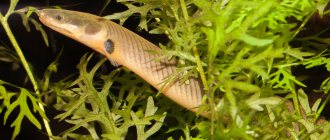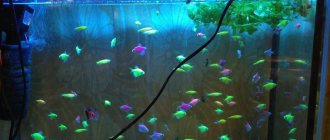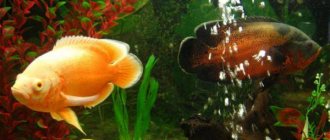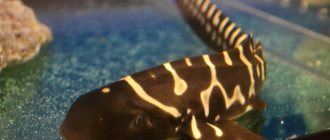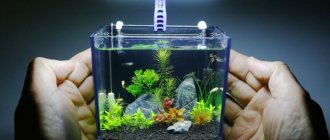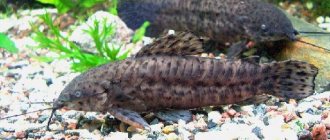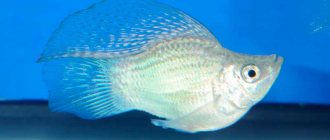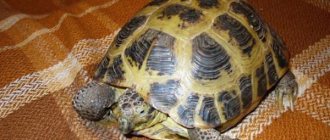Molly fish
molly inhabits only lakes and rivers of the Yucatan Peninsula in Mexico. Mollies latipinna lives in brackish waters of Virginia, Florida, the Carolinas and Texas. Mollies sphenops live in a variety of bodies of water from Mexico to Colombia.
How to distinguish a female from a male molly?
In all breeds and species, females are noticeably larger than males. Velifera females grow up to 18 centimeters, Latipinna - approximately 10 -12 centimeters in size, and Sphenops - about 6 - 8 centimeters in length. Gender is determined by the shape of the anal fin - in males it is pointed, and in females it is rounded.
Description and appearance
The black molly is an artificially bred viviparous species, the size of which is about 10 cm. It has a completely dark color with a velvet tint. The body is oblong, stocky and not very flattened laterally. The mouth is slightly raised and the eyes are large and round.
On the question, how long does this fish live? We can safely say from three years or more, much depends on her living conditions.
Black mollies
Most often, only black, selective varieties of mollies are found on sale these days. But the marks of black molly, as they are called by amateur aquarists, usually contain a small number of spotted fry, in which black scales alternate with light and greenish-bluish ones, like the natural form.
Relatively recently, a variety of forked mollies with a notched caudal fin and long upper and lower rays, and scarf mollies with an elongated dorsal fin, were bred.
Peculiarities
In females, puberty occurs at 5–6 months, in males at 8–12 months. To prevent the female from chasing the male, three females are placed with one male. Molly fish reproduce in salt and fresh water.
If the male is removed from the aquarium after giving birth, the female gives birth by preserving the fertilized eggs. A fish that has given birth remains fat because it does not give birth to all of them at once, but continues to carry fertilized eggs. The fry are born within 35–50 days after birth. Mollies are characterized by a change of sex from female to male if living conditions require it. This preserves the fish population.
Before breeding, find out the differences between a female molly and a male.
Aquarium mollies
Among all viviparous fish, mollies are considered the most capricious and difficult to keep and breed. The size of the aquarium for keeping them should be significant, with the expectation that a pair of adult fish would have about 6 liters of water or more. In an aquarium, it is desirable to have a long-established biological balance of the environment. The water should be clean, transparent, aerated, without turbidity. Hardness dH ranges from 10 to 25°, pH from 7.2 to 8.5. It is advisable to replace a quarter of the volume of water weekly with fresh and settled water.
Aquarium maintenance and care
In the wild, mollies habitat can vary greatly. They have adapted to many different conditions, including tolerance to brackish waters and high levels of acidity.
For several fish you need approximately 60 liters, preferably from 100, since you will not only be keeping them. They themselves can grow up to 10 cm, and in very small aquariums they will be cramped.
Each additional fish will need approximately 5 liters to live comfortably. The main reason we preach that larger aquariums are better is because they are easier to care for. Fish can adapt quite easily to a smaller living space, but water quality is a factor that is very unstable in small aquariums.
The more water, the easier it is to keep the aquarium clean. The larger your water container, the more diluted the water will be with fish poop and uneaten food sinking to the bottom of your tank. The smaller the body of water, the easier it becomes polluted.
Water parameters can be very different, as they perfectly adapt to local conditions. But it is recommended: water temperature 23-28C, ph: 7.0-8.0, hardness 20 - 30 dGH. Captive-bred mollies are accustomed to different conditions, so you don't have to worry about each species needing different water.
Note that fish tolerate salted water very well, and many resources even advise adding salt to it specifically.
Yes, this will not make them any worse, but do not forget that they rarely live in an aquarium by themselves, but their neighbors can tolerate increased salinity very, very poorly.
I would only recommend using salt if they are alone in the tank or for quarantine purposes.
As for the design of the aquarium, it is completely up to you. It is recommended that there be a lot of plants in it, as mollies like to scrape off plaque and algae from them.
A layer of sandy substrate is a good idea. Although they won't spend much time on the bottom, fine grains of sand are good for rooting plants.
You can choose your favorite plants, but taller bushes such as Vallisneria provide good cover for these fish.
It would also be desirable to have a filter; an internal one would be sufficient. Be sure to change up to 20% of the water weekly, as they quickly contaminate it.
Care for them like all other fish: feeding and regular water changes, otherwise they are very unpretentious.
Male (bottom) and female
Mollies content
It is necessary to provide the aquarium with a large number of open, well-lit areas. You will also need the presence of dense thickets of vegetation, snags, and rock slides for shelters. A significant part of the time, mollies swim in the middle and upper layers of the water of the aquarium.
All mollies are fairly heat-loving fish and prefer water with a temperature of 25 - 30 degrees. When the temperature of the water decreases or its quality properties deteriorate, and even more so when these unfavorable circumstances combine, they press all the fins to the body and move weakly, sometimes lying on the bottom or swaying in one place. This situation can often be corrected by increasing the temperature to the optimal value and replacing a third of the water with fresh, settled water. It is also a good idea to add sea or regular table salt to the water at a ratio of 2 - 3 g per 1 liter of water.
Fish are demanding when it comes to aquarium lighting - daylight should optimally last at least 12 hours. Lighting intensity at the rate of 0.5 - 0.7 W per liter with lamps with an increased red wavelength in the spectrum. It is a good idea to have the aquarium exposed to natural sunlight for 2 hours, but this is not necessary.
What to feed mollies?
Mollies are omnivorous and not picky. They are fed any live, dry or plant food. The diet of the fish must certainly include plant components. Make sure your fish's diet is as varied as possible.
Feeding
Black molly is an omnivorous fish. Relatives in nature feed more on plant food. Aquarium hybrids need a varied diet.
Feed 1-2 times daily. In addition to the mandatory fasting day.
Live food
Bloodworms and tubifex are high in calories and contain essential substances and vitamins. Regular eating causes obesity. They are mined at the bottom of standing reservoirs. There is a risk of introducing parasites and infections, and fish poisoning.
The coretra is not so dangerous because it lives and feeds in the water column. Not as nutritious.
Daphnia, gammarus and brine shrimp are bred at home. Experienced aquarists solve the problem of the safety of live food in this way. Nauplii, Artemia larvae, are used to feed the fry.
- Live food contains nutrients and beneficial substances in a form accessible to fish.
- Uneaten, does not spoil water.
- Caught in dirty waters is dangerous.
Frozen food
Safe against infections and parasites. Even products from trusted manufacturers poison fish. During storage and delivery, there is a possibility of defrosting, which is unacceptable.
- Contains the same ingredients as live food.
- It is necessary to siphon off the remains.
- Risks poisoning.
Dry food
It is produced in the form of powders, flakes and tablets. The food is balanced and contains vitamins, micro- and macroelements. Manufacturers:
- Hikari;
- Zoomworld;
- Tropical;
- Aller Aqua;
- TETRA;
- SERA;
- JBL.
If you are leaving, install an automatic feeder with a timer.
- No preparation required.
- Contains the necessary ingredients.
- Safe.
- The presence of the owner is not required.
- Residues must be removed.
Plant food
- Black mollies need plant fiber. Plant food makes up 30% of the diet.
- Spirulina tablets and flakes. Spirulina is a cross between a bacterium and an algae. This makes the composition specific. Not enough fiber (9-11%). The vitamins, micro- and macroelements contained will strengthen the immune system. Blanched vegetables - cucumber, zucchini, cabbage. Spinach and greens will do. Dried nettle is rich in vitamins.
- Crushed and blanched oat flakes (“Hercules”), semolina.
Top dressing
Used to diversify the diet. Feed with hard-boiled chicken egg yolk. Chopped boiled meat, liver. Chopped sea fish. Raw river fish should not be given due to the presence of parasites and infections.
General recommendations
- None of the listed foods are suitable for constant feeding. Diversify your diet.
- A lack of plant food in the diet will affect the condition of the plants. The black molly will eat the algae and attack the grass.
- Overfeeding threatens gastrointestinal disorders and obesity. Don't forget about fasting days.
- Remove uneaten food. It spoils the water and provokes the growth of algae.
Reproduction of mollies
Mollies are viviparous fish. Puberty in fish occurs at the age of about 1 year. Gestation of fry lasts 35-45 days.
Molly fry
At one time, the female gives birth to up to 50-60 fairly large fry. You should know that molly fry are very vulnerable to pollution in the aquatic environment, so in an aquarium with fry it is recommended to change some of the water more frequently than usual. To increase the immune properties of the fry, you can add a little salt to the water. Primary food: Artemia and Cyclops nauplii, “live dust”, crushed high-quality artificial food.
Neighbors and compatibility of black molly
Neighbors for black molly should be selected according to the size of the inhabitants. It is not recommended to keep fish with bright, large fins or tails with them. It is very likely that they will sooner or later attract mollies as possible food.
Nannakars, cichlasomas, ancistrus and macracanths are very active fish.
Calm and non-conflict fish species get along well with molly. Excellent neighbors will be catfish, loaches, any species of swordtails, neons, rhodostromus, thornets, gourami. It is recommended to select active and schooling fish as neighbors for the molly.
Did you know? There are special types of fish in the world, which were called lungfish. They have both gills and lungs. Thanks to this body structure, the animal can live without water for up to two months.
Types of mollies:
Mollies sphenops
Mollienesia sphenops has a laterally flattened, rather dense and elongated body. The head of this fish is relatively small, the eyes are large, and the lips are slightly upturned. The fins are relatively small. The dorsal fin contains 10-11 rays, the caudal fin - 22-24, the anal fin - 8-9 rays. The base of the caudal fin is quite wide. The caudal fin is rounded and well formed. There is a pointed gonopodium (a mobile sexual copulatory organ characteristic of poeciliids) with a membranous hook located on the third ray. Sphenops has a fairly diverse range of colors. Several color variations have been artificially bred: a silvery form (which is the wild, original form), a yellowish-gray form with dark spots, a yellowish-orange variation, and a pure black one, which is the most popular form (can be seen in any pet store and bird market).
Sexual differences in mollies: male - in natural conditions reaches 8 cm in length (in aquarium conditions up to 6 cm); female - has a more pronounced abdomen; in the wild, individuals up to 10-12 cm in length are found (in aquarium conditions up to 10 cm). Life expectancy in captivity is up to 5 years.
Mollies sphenops is a fairly peaceful, active and cheerful fish. It is better to keep them in a flock with a predominance of females. Gets along well with many types of aquarium fish except tiger barbs (you should never keep them together!). Some males behave quite hostile towards members of their own species. The fish swims mainly in the middle and upper layers of the aquatic environment.
This viviparous fish should be placed in a covered aquarium of at least 70 liters (about 10 liters per fish) with good (resembling natural) lighting. It should contain thickets of aquatic plants, all kinds of shelters, and also have a free area for movement. The optimal soil is medium-sized gravel. Characteristics of water for an aquarium with sphenops: hardness 11-25 degrees, active reaction 7.5-8.0, water temperature 24 - 27° degrees. Aeration, filtration and weekly changes of up to a third of the total water volume are required. It is recommended to add salt from time to time (sea or regular table salt 1.5 grams per 1 liter of water). The fish is prone to fungal infections. Molly sphenops feeds on a variety of types of food: - plant food (you can thinly sliced spinach and lettuce, food bran and algae growth) - live food (bloodworms, daphnia, mosquito larvae, coretra, earthworms), as well as artificial substitutes. Fish are often prone to overeating by nature.
Genera of mollies
Sphenops is a viviparous fish.
The duration of pregnancy is from 4 to 8 weeks. A pregnant fish is kept in a closed top aquarium with floating plants and various hiding places. From time to time, replace the water with small portions. The female is fed live, high-quality dry and plant food. If the female is kept incorrectly, the fry may be born dead or completely non-viable. After the birth of the fry, the female is immediately removed. Fertility up to 100 large fry. They begin to swim immediately after their birth. Sphenops fry are fed with Artemia nauplii, “live dust”, cyclops, chopped spinach, boiled egg yolk, and algae. They grow quite quickly. When it is possible to determine the sex of the fry, males and females are seated and kept in separate aquariums for six months. Reaches sexual maturity at approximately 9-12 months. Mollies are very beautiful viviparous fish from the Poecillidae family. The most popular and widespread is the “black molly” (Poecilia sphenops). The noble varieties of this fish are completely velvety black. The black color is the result of careful selection work by patient aquarists. In natural conditions, the color is variegated with black, bluish and gray spots. In particular, absolutely black fish with cherry edging on their unpaired fins are highly valued. The length of females reaches 10-12 centimeters, males are slightly smaller.
When keeping and breeding, you must adhere to three rules: 1) do not let the fish catch cold - the most optimal temperature for mollies is above 24 degrees, 2) do not keep them in very soft water (in water with a hardness below 6 degrees they very often get sick and degenerate over time) ; 3) do not feed exclusively with food of animal origin - both adult fish and especially fry need food of plant origin (filamentous and green algae, algae fouling on plants and the walls of the aquarium). Fish love sunny and bright artificial lighting, dense thickets of aquarium plants. Intensive aeration and biological filtration are highly desirable, since fish love fresh water, and systematic partial change of water (about a quarter of the total volume). When adding fresh, settled water, you must strictly ensure that it is at the same temperature as in the aquarium.
The female with a grown abdomen is placed in an aquarium with fresh water and dense thickets of aquatic plants. Spawning occurs mainly one to two hours after sunrise. The fry are more vulnerable than those of swordtails and guppies, and initially often lie on plant leaves and the bottom.
If not properly maintained, the female may release premature eggs or non-viable fry with a large yolk sac. Often such unsuccessful spawning occurs in a cramped container at high water temperatures (above 28 degrees). Feeding the fry is not particularly difficult.
Mollienesia sphenops is the most common species of relatively undemanding fish. Feels great in soft and hard water at a temperature of 22-24 degrees. Like the bulk of aquarium fish, they become smaller when constantly kept in small containers, and especially when there is significant overcrowding. Apparently, fish waste products that have reached a certain accumulation in the water have a retarding effect on the growth of aquarium fish. Also, in a spacious aquarium with plants, animal and plant life is more diverse, which serves as an additional stimulator for the growth and formation of fish, especially in the early stages.
The natural form of this species has a silvery or yellowish background color, over which bluish-black or velvety spots are scattered. Among amateur aquarists, the velvet-black variety of mollies, bred through artificial selection, is deservedly most popular. But even now, from pure black breeders, from time to time spotted fry appear, whose black scales are mixed with bluish-green and silver, like the natural form.
Some experts consider the black molly to be descended from the mollies latipin. But this opinion is quite controversial. Large individuals of black molly with a high fin in the form of a sail have an undeniable resemblance to the lapipina in size, and especially in the shape of the dorsal fin in males, which is characteristic of the lapipina. As for the bulk of black mollies of medium size and with simple fins, their appearance, and especially the spotted fry that emerge from them, bear the characteristics of Sphenops. It is possible that this is a hybrid form of both types of mollies. In recent decades, the assortment of aquarium black mollies has been supplemented by forked and scarf fish with elongated caudal and dorsal fins. At one of the competitions in the field of breeding aquarium fish in Moscow, hybrids of mollies and guppies, resulting from natural copulation, were presented. The fish turned out to be quite interesting in their shape and color, but, unfortunately, they were absolutely sterile.
Molliesia free
Free mollies (Mollinesia salvatoris). For many years it was considered a form of Mollienesia sphenops. Comes from the reservoirs of Guatemala. This magnificent fish with black, white and red pelvic and dorsal fins is not often found in aquariums. It is more undemanding than the broad-finned varieties and can live in soft water without the addition of sea or table salt. Can be kept in a community aquarium with peaceful fish. It is better to keep individuals with long fins separately, otherwise neighbors may tear them. Feed of plant origin with small portions of animal feed is desirable.
Molliesia velifera
Velifera mollies or sail mollies (Poecilia velifera) are excellent aquarium fish that have earned their name for their enormous dorsal fin, which has the shape of a slightly irregular trapezoid with rounded upper edges. This remarkable decoration is characteristic only of mature males raised in the best conditions. Such males attract attention not only with the unusual size and configuration of the dorsal fin, but also with the most interesting colors of the fins and body.
Against the general background of a rather monotonous and discreet silvery-yellow color, shining dots located in symmetrical lines sparkle with blue, greenish, gold and red glimmers. The dorsal sail-fin is framed along the upper edge by a strip of luminous blue and red dots, and the caudal rounded fin is dotted with blue shining dots. These are the largest fish from the mollies family. In their homeland, mature males have a body length of up to 15 cm; in aquariums they often do not grow more than 12 cm. Females of this species are much paler in color and do not have a sail-like dorsal fin.
Velifera molly was first introduced into Russia in 1913. But before 1941 they were extremely rare in aquariums. In the post-war period, they were re-imported from European countries. But even now they remain a rather rare decoration in the collection of viviparous fish of the most experienced amateur aquarists.
These fish are quite picky about the conditions in the aquarium. They need an optimal temperature of 24-26 °C, a separate spacious aquarium with a volume of 50 liters or more. They need slightly brackish water (one teaspoon per bucket of water) and a variety of live food with the addition of plant components in the form of various algae, chopped lettuce or specialized fertilizer - for example.
These aquarium fish mature relatively slowly. Males achieve proper coloring only after a year. If the best growing requirements are not met, velifera mollies remain dim and do not have their main decoration - a lush dorsal fin. In aquariums there are mainly hybrid forms of Poecilia velifera crossed with Poecilia latipinna. It is the object of selection - this species has different color varieties. The most famous options:
- the original form (natural) is gray-silver with shiny iridescent dots, males have a beautiful yellow-golden coloration of the throat, chest and a reddish rim along the upper edge of the dorsal fin;
- marble shape (trade name “snowflake”) - dazzling white body, coal eyes, white fins with a bluish tint. Due to its delicate, unique beauty, this variety has deserved popularity among aquarists;
- coffee form - the color of roasted coffee, with a nice matte tint and brown spots on the caudal and dorsal fins. In hobby aquariums it is found less often than other varieties;
- the golden form (albino) is yellow-orange with a white-bluish tint of scales. The eyes are red, which is typical for albinos;
- black form (rainbow) - called “Nigra” - dark, almost completely black color of the body; when viewed from the side, the scales have an iridescent tint, and the translucent caudal and dorsal fins are covered with dark dots.
Recently, new forms have been obtained - leopard and burgundy. All varieties can have lyre-shaped or simple caudal fins.
Molliesia latypina
Mollies latypina are distinguished by significantly more modest dimensions and a more angular configuration of the sail-like dorsal fin in males. This mollies Velifera, as it were, in miniature, and in its true form, is mostly unfamiliar to our amateur aquarists. Some of the fish, called velifers and high-finned black molly, contain characteristics of this species, apparently transformed by breeding with the two above-mentioned species.
Molliesia dwarf
Dwarf mollies (Mollinesia chica). The male is 3 cm in size, the female is about 4 cm. Peaceful fish. Can be kept in a common aquarium with calm neighbors, with thickets of aquarium plants, snags, grottoes and rocks for shelter. It would be nice to place a group of mollies with a predominance of females in a spacious container. Regular weekly water changes, powerful aeration and biological filtration are required. The fish is susceptible to a lack of oxygen and cannot tolerate highly polluted water in the aquarium - otherwise all sorts of diseases can develop. The temperature of the content fluctuates within a fairly wide range from 17 to 31 degrees, the pH of the environment is 7–8.
Mollies Peten
Peten mollies (Mollinesia petenensis). Lives in Guatemala in Lake Peten. The male reaches 12 cm, the female about 8 cm. It is similar in build and coloring to the velifera, but the lower part of the caudal fin has a black sword-shaped process. The body and fins have burgundy and mother-of-pearl dots, the dorsal fin is edged with red. If you are a beginner amateur aquarist, mollies are just the thing for you. It is interesting that attempts to obtain offspring from this species were made at the end of the nineteenth century, but were unsuccessful: only in 1910 in Germany was the fish successfully bred in captivity.
Fish diseases and treatment methods
Wild forms of mollies are very resistant to various diseases. However, domestic ones are the result of closely related crossings, and therefore are much weaker. If the fish shakes in place, presses its fins, dives to the bottom and immediately rises, it is quite possible that it is sick. Raise the temperature in the aquarium and replace some of the water with fresh water, and then try to deal with the disease. There are so many of them that it is difficult for a simple amateur to make a diagnosis without a specialist. Fortunately, many of them are treated with the same medications, and often simply by bathing in a solution of table salt (3-5 g/l) or potassium permanganate (faint pink).
Sometimes the fry are severely stunted in growth. In the fish world, this is normal: not everyone gets equal amounts of vitality. But if the entire litter does not grow, reconsider the conditions of detention - raise the water temperature, change the feeding regime. A serious disease would quickly wipe out all the young.
Contagious diseases
All fish diseases are divided into contagious (they are caused by viruses, bacteria, fungi and parasites) and non-contagious (congenital diseases or poisoning due to poor ecology). For example, abundant white spots on the body of a fish almost always mean that protozoan parasites have settled on it. They appear first on the head and fins, then spread throughout the body. The common name for this disease is ichthyophthyriosis (literally, fish louse). The cycle of protozoa in an aquarium occurs quickly, and getting rid of them is not an easy task. Sometimes increasing the temperature of the water and changing it frequently helps in treatment, but you also have to use special agents - Micronazole or Tripaflavin.
Universal medicines for parasites are bicillin-5, biomycin and other antibiotics. Dyes often help - basic violet K, malachite green, methylene blue.
Also contagious are:
- Ichthyosporidosis is an incurable disease. Its symptoms are spasmodic movements, exhaustion, refusal to feed, a constantly open mouth, ulcers and bulging eyes. It is necessary to disinfect everything that was in the aquarium.
- Gyrodactylosis - the fish stays at the surface of the water, swaying its whole body, individual parts of the body are bluish-matte or gray in color, refusal to feed, ulcers, clouding in the eyes, bluish-white covering on the gills.
- Glugeosis - mollies swim on their side, knob-like protrusions, whitish or bloody spots and tumors are noticeable on certain parts of the body. Sick fish are destroyed and everything is disinfected.
White spots starting from the head of the fish and spreading to the entire body can be cured
Colds and illnesses due to improper care
Mollies often get sick with common colds: they are heat-loving fish. Symptoms: loss of appetite, slowness, constant presence at the top of the aquarium. The treatment is simple - raise the water temperature to the required values, and the fish’s immunity will do everything itself. Due to errors in care, other diseases appear:
- Alkalosis - the skin becomes dull, breathing quickens, mucus is released from the gills, and the fish rush around the aquarium. For treatment, mollies are transplanted into fresh water.
- Choking, rapid breathing - pour in a 15% solution of hydrogen peroxide at the rate of 1 ml/1 liter of water.
- Branchiomycosis - appetite worsens, fish stay in the corners of the aquarium, gray stripes appear on the gills. Treatment is carried out in a separate vessel with a solution of copper sulfate and chloramphenicol.
- Gas embolism - clouding of the lens of the eye, trembling throughout the body, anxiety. Change the water.
- Chlorosis is anxiety, the gill filaments become covered with mucus, become lighter in color, the fish stop responding to external stimuli and die. For treatment, they are transplanted into fresh water and the chlorine content is monitored.
- Obesity - inactivity, enlargement of the anterior abdomen. The disease usually ends in death.
Poisoning
It is diagnosed by the following signs:
- change in color brightness;
- convulsive movements;
- scales and gill covers protrude, fins are destroyed;
- restless behavior, and then lack of response to stimuli;
- jerking, loss of balance.
For treatment, the fish are transplanted into another aquarium, but recovery is slow and not always possible. With inflammation of the gastrointestinal tract, mollies become sluggish and dull. Their anus turns red, stool takes on a thread-like shape, and their appetite decreases. The fish are not fed for a week, and then given small portions of a variety of food.
Table: common fish diseases and treatment methods
| Disease | Symptoms | Treatment |
| Argulosis (pathogen - carp eater) | Copious secretion of mucus near the inflamed wound, the fish sways and rubs against the stones. | The fish with the parasite is caught, placed in a damp swab and the parasite is removed with tweezers, and then a lotion is made with potassium permanganate or trypaflavin. |
| Acidemia (ammonia poisoning) | Darkening of the color of fish. They are trying to jump out. | Replacing water with fresh water. |
| Hexamitosis | Severe exhaustion, redness of the anus. | Treatment in a separate vessel with erythrocycline (40–50 mg/l) with the addition of trichopolum (10 mg/l) for 10–12 days. |
| Fin rot | Initially, there is a bluish-white clouding of the edges of the fins, then the ends of the rays of the fins disappear, the edges become splayed. White sores form at the base of the fins | In a separate vessel: malachite green, bicillin-5, hydrochloride. |
| Dactylogyrosis | The fish is restless, stays near the surface, greedily swallowing air, does not take food, sways, rubs against objects. The gills turn pale, become covered with a large amount of mucus, the edges are corroded, and the petals grow together. | In a separate vessel: bicillin-5, copper sulfate, hydrochloride, formalin. |
| Dermatomycosis | White thin threads appear on certain areas of the skin, fins, and gills, followed by a cotton wool-like coating of white or light yellow color. | If the fish has another disease, then treat it. Otherwise, therapeutic baths in a common aquarium with streptocide or in a separate aquarium with potassium permanganate, copper sulfate, bicillin. |
| Costiosis | First, the fish rubs against objects, then refuses to feed, bluish-gray spots appear on the body, turning into a veil, the gills become covered with mucus, and the fins are glued together. The fish makes rocking movements and finally dies. | In the general aquarium - trypaflavin, methylene blue, bicillin-5, and in a separate vessel - potassium permanganate, table salt, rivanol, copper sulfate, malachite green, hydrochloride. |
| Lerneosis | The fish sways, rubs against objects, ulcers with bright red edges are visible on the body, in which you can see the crustacean with a magnifying glass. | The crustacean is removed by placing the fish in a wet cotton swab. In a separate vessel: solution of table salt 8 g/l for 2–3 weeks or hydrochloride (0.2 mg/l) for 4 days. Lotions with trypaflavin or potassium permanganate. |
| Lepidorthosis | Ruffled scales. | In the general aquarium: bicillin-5, biomycin, white streptocide; in a separate vessel: hydrochloride. |
| Plastiphorosis | The color of the fish fades. Schooling fish stay solitary. They stop taking food, lose weight, hold their tail down at an angle of 60 degrees, make jerking movements, the spinal column is curved, and sometimes the fins are destroyed. | The fish die. Plants and aquarium are disinfected. |
| Trichodinosis | At first, the fish stay near the aeration bubbles, rubbing against the ground, stones and plants. There are matte areas on the body. Then the body becomes covered with a whitish coating, the fish does not take food. | Tripaflavin, methylene blue, table salt. |
| Tuberculosis | Lethargy, refusal to feed, stand in the corners of the aquarium, tail down, lie on their side near the ground, sway, color fades, fin rays are destroyed, scales fall out, ulcers, bulging eyes, black spots on the body. | The disease is incurable. Destroy fish and plants, thoroughly disinfect the rest. |
| Peptic ulcer | There are small dark spots on the body that turn into red ulcers. At autopsy, inflammation of the intestines may be observed. | In the general aquarium - bicillin-5, white streptocide, and in a separate vessel - potassium permanganate and hydrochloride. |
The black molly is an aristocratic beauty that lives in many amateur aquariums. Being a representative of viviparous fish, it does not cause any problems in breeding. In addition, the black molly is not picky about food, gets along with many neighbors, loves warmth, and in a good aquarium will always be its decoration.
